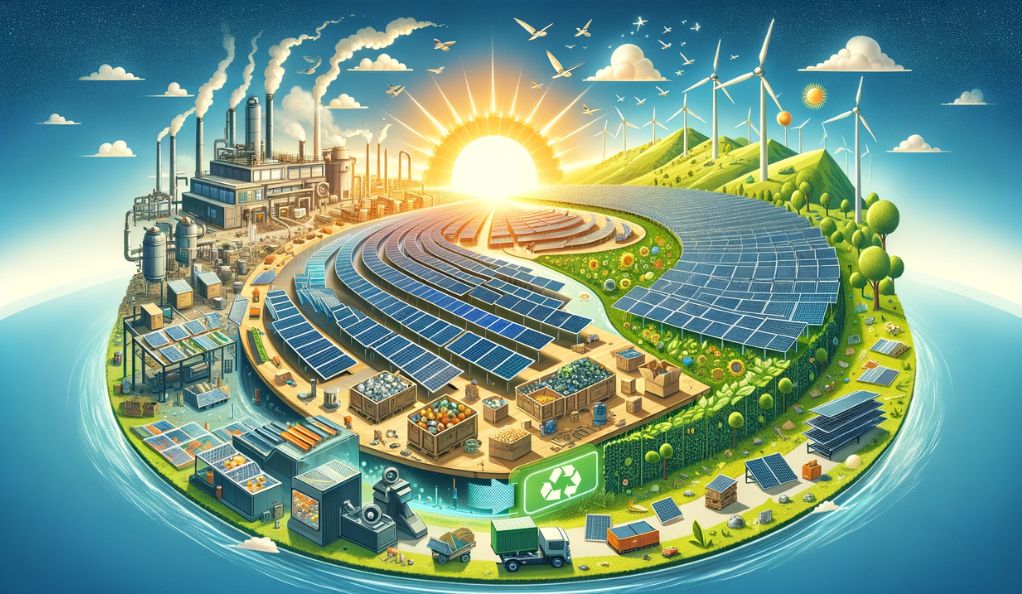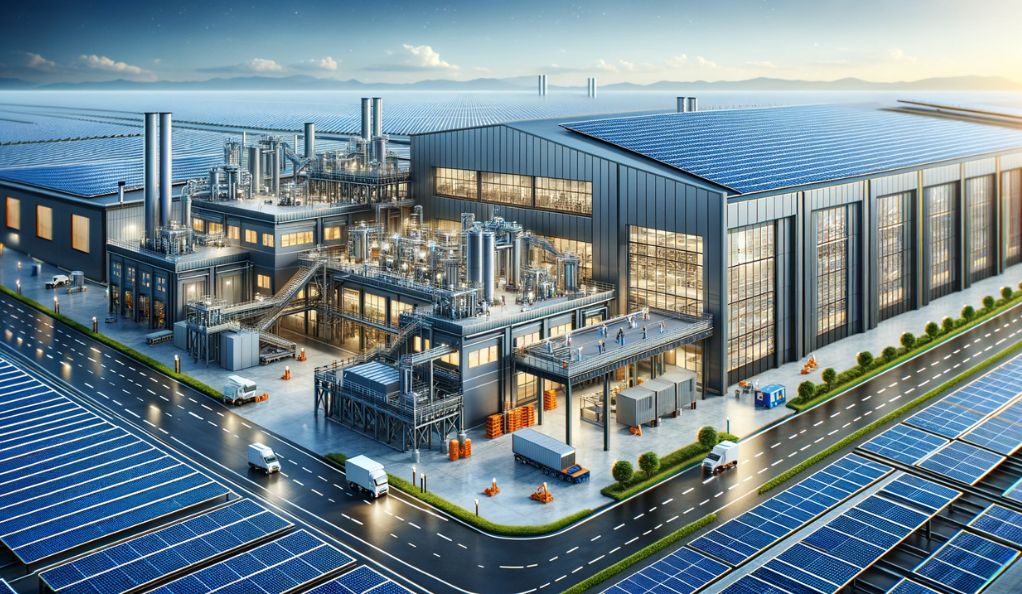Introduction
The world is at a critical juncture in its quest for clean, renewable energy sources, and solar power has emerged as a shining beacon of hope. As we face the urgent need to mitigate climate change and transition away from fossil fuels, solar panels have gained prominence as a pivotal technology in achieving a sustainable future. However, while harnessing sunlight to generate electricity may seem inherently eco-friendly, the production of solar panels has not always been in harmony with environmental goals. This article delves into the fascinating world of sustainable manufacturing of solar panels, exploring how the solar industry is undergoing a transformation to ensure that it plays a pivotal role in the global green revolution.
The Growing Importance of Renewable Energy
Before delving into the intricacies of sustainable solar panel manufacturing, it’s crucial to understand why solar energy is so essential in the first place. The urgency of transitioning to renewable energy sources cannot be overstated.
Climate Change Mitigation: Fossil fuels, such as coal, oil, and natural gas, have been the primary sources of energy for centuries. However, their combustion releases greenhouse gases into the atmosphere, primarily carbon dioxide (CO2). These gases trap heat and contribute to global warming, resulting in climate change with devastating consequences. The burning of fossil fuels is the largest driver of human-induced climate change, making it imperative to find alternative sources of energy that do not emit CO2.
Energy Security: Relying on fossil fuels for energy is not only environmentally damaging but also poses security risks. Nations that are heavily dependent on oil and gas imports are vulnerable to geopolitical conflicts and price fluctuations. Renewable energy sources, like solar power, can enhance energy security by reducing dependence on finite and geopolitically sensitive resources.
Economic Opportunities: The shift towards renewable energy offers significant economic opportunities. It has led to the creation of green jobs, spurring innovation, and driving economic growth. The renewable energy sector is increasingly recognized as a cornerstone of future economic prosperity.
Environmental Benefits: Solar energy is abundant, free, and clean. Harnessing the power of the sun for electricity generation reduces air and water pollution, minimizes habitat destruction, and mitigates the adverse impacts associated with extracting and transporting fossil fuels.
Access to Energy: Solar power has the potential to provide electricity to remote and underserved communities worldwide. Its scalability and versatility make it an ideal choice for improving energy access in regions with limited infrastructure.
The importance of renewable energy, particularly solar power, in addressing these global challenges cannot be overstated. Solar panels, as the primary technology for capturing and converting sunlight into electricity, play a pivotal role in this transition. However, to fully realize their potential as a sustainable energy solution, it is imperative to address the environmental and ethical aspects of solar panel production.
The Solar Panel Lifecycle

Solar panels are remarkable devices that convert sunlight into electricity, but their journey from raw materials to energy-generating powerhouses is a complex one. To understand the importance of sustainable manufacturing, we must first examine the entire lifecycle of solar panels and identify key stages where eco-friendliness can be optimized.
Overview of the Solar Panel Production Process
The production of solar panels can be broken down into several key stages:
- Raw Material Extraction: The process begins with the extraction of raw materials, primarily silicon, which serves as the foundation for solar cells. Silicon is abundant in nature, but its extraction and purification can be energy-intensive.
- Wafer Production: Once the silicon is purified, it is transformed into thin wafers, typically using the Czochralski or Float-Zone method. These wafers serve as the base for solar cells.
- Solar Cell Manufacturing: Solar cells are the heart of a solar panel. They are created by treating the silicon wafers with various materials to form semiconductor layers. This is where the conversion of sunlight into electricity takes place.
- Module Assembly: Solar cells are interconnected, sealed, and encapsulated in a protective module. These modules are then framed and wired to create a functional solar panel.
- Quality Control and Testing: Rigorous quality control and testing ensure that each solar panel meets industry standards and performance criteria.
- Distribution and Installation: Solar panels are distributed to markets and installed on rooftops, solar farms, or other suitable locations.
- Operation and Maintenance: Solar panels operate for decades, converting sunlight into electricity. Regular maintenance ensures optimal performance.
- End-of-Life Management: Eventually, solar panels reach the end of their useful life, at which point they need to be recycled or disposed of properly.
Identifying Environmental Impact Hotspots
Throughout this lifecycle, certain stages have a more significant environmental impact than others. Identifying these hotspots is crucial for sustainable manufacturing. Here are some key considerations:
- Energy Consumption: The energy-intensive processes of silicon production and wafer manufacturing can result in substantial carbon emissions if the energy source is not green.
- Chemical Usage: Chemicals used in solar cell manufacturing, such as solvents and dopants, can have environmental and health implications if not managed properly.
- Water Usage: Silicon purification and solar cell production can require substantial amounts of water, which may strain local water resources in arid regions.
- Waste Generation: The production process generates waste, including silicon dust, off-cuts, and unused materials, which need proper disposal or recycling.
- Transportation: The transportation of raw materials, components, and finished panels over long distances can lead to carbon emissions.
To address these issues and make solar panel manufacturing more sustainable, innovative approaches are being adopted across the industry. Sustainable materials, energy-efficient manufacturing, and waste reduction strategies are being implemented to reduce the environmental footprint of solar panels.
Sustainable Materials
Choosing the right materials is a fundamental aspect of sustainable manufacturing in the solar panel industry. The selection of materials impacts not only the environmental footprint but also the overall performance and longevity of solar panels. In this section, we will explore how the industry is embracing sustainable materials to reduce its environmental impact.
1. Silicon Alternatives
Silicon has been the dominant material for solar cells, but researchers and manufacturers are exploring alternative materials to reduce the reliance on energy-intensive silicon production. Some promising alternatives include:
- Thin-Film Solar Cells: Thin-film solar cells use materials like cadmium telluride (CdTe), copper indium gallium selenide (CIGS), and amorphous silicon (a-Si) as semiconductors. These materials require less energy to manufacture and can be deposited in thin layers, reducing material usage.
- Organic Photovoltaics (OPV): Organic solar cells are made from carbon-based polymers and small molecules. They offer flexibility, lower production costs, and the potential for recyclability.
2. Recycled and Upcycled Materials
To minimize waste and reduce the environmental impact, the solar industry is increasingly turning to recycled and upcycled materials:
- Recycled Silicon: Recycling silicon wafers and cells from end-of-life solar panels or semiconductor waste can significantly reduce the need for virgin silicon.
- Reclaimed Glass: Glass is a common component in solar panels. Using recycled glass reduces the energy required for glass production and diverts waste from landfills.
- Upcycled Materials: Some companies are exploring creative ways to reuse materials that might otherwise be discarded. For example, repurposing retired sailboat sails as encapsulant films for solar panels.
3. Sustainable Encapsulation Materials
Encapsulation materials protect solar cells from environmental factors like moisture, dust, and UV radiation. Traditional encapsulants are often made from ethylene-vinyl acetate (EVA) or similar materials. However, newer options include:
- Bio-based Encapsulants: Some manufacturers are developing encapsulants derived from renewable and bio-based sources, reducing the reliance on petrochemicals.
- Recyclable Encapsulation: Researchers are working on encapsulant materials that can be easily recycled at the end of a panel’s life, reducing waste.
4. Transparent Conductive Materials
Transparent conductive materials are used as top layers in solar panels to allow sunlight to pass through while efficiently conducting electricity. Indium tin oxide (ITO) has been the traditional choice, but it is expensive and can be problematic due to indium scarcity. Sustainable alternatives include:
- Silver Nanowires: These nanoscale conductive wires offer a more sustainable and flexible option for transparent conductive layers.
- Graphene: Graphene-based materials show promise for their excellent conductivity and sustainability.
5. Eco-Friendly Packaging
Sustainable materials aren’t limited to the solar panels themselves. Eco-friendly packaging materials can reduce the carbon footprint associated with transportation and distribution. Manufacturers are exploring recyclable and biodegradable packaging options.
6. Lifecycle Assessment
To make informed decisions about materials, many solar panel manufacturers conduct comprehensive lifecycle assessments (LCAs). LCAs analyze the environmental impact of a product from cradle to grave, helping companies identify areas for improvement and select the most sustainable materials and processes.
Energy Efficiency in Manufacturing

Energy efficiency stands as a critical pillar in the drive towards sustainable solar panel manufacturing. The production of solar panels, despite its clean energy goal, requires substantial energy input. To lessen its environmental impact and carbon footprint, the industry is embracing energy-efficient practices and integrating renewable energy sources.
Reducing Energy Consumption
A primary strategy for sustainable solar panel manufacturing centers on curtailing energy consumption throughout the various production stages. Energy reduction efforts are particularly prominent in the following areas:
Silicon Production: The production of silicon wafers is known for its energy intensity. By adopting advanced technologies and processes that require less energy, manufacturers can significantly reduce the carbon emissions associated with this stage.
Solar Cell Manufacturing: Innovative manufacturing techniques, such as the use of laser technology for cutting and patterning, can minimize energy requirements while improving precision and efficiency in solar cell production.
Module Assembly: Streamlining assembly processes and improving automation can lead to lower energy consumption. Additionally, the use of more energy-efficient encapsulants and adhesives can contribute to reduced energy use during this stage.
Harnessing Green Energy Sources
A significant step towards sustainability involves incorporating renewable energy sources directly into solar panel manufacturing facilities:
Solar Power: Manufacturers are increasingly installing solar arrays on the rooftops of their production facilities. These on-site solar installations not only generate clean energy for the manufacturing process but also serve as a powerful demonstration of the technology’s capabilities.
Wind Energy: In regions with favorable wind conditions, wind turbines can complement on-site solar installations, further reducing the carbon footprint of manufacturing plants.
Hydropower: Facilities located near water sources can harness hydropower for their energy needs, providing a consistent and renewable energy source.
Net-Zero Energy Facilities
Forward-thinking solar panel manufacturers are actively pursuing net-zero energy facilities, where the energy generated equals or surpasses the energy consumed during production:
Energy Management Systems: Advanced energy management systems continuously monitor energy consumption in real-time, enabling precise control and optimization of energy usage.
Energy Storage: The integration of energy storage solutions, such as batteries, allows manufacturers to store excess energy generated during the day for use during non-sunlight hours, reducing reliance on the grid.
Energy-Efficient Building Design: Sustainable manufacturing facilities incorporate energy-efficient building design principles. This includes passive solar design, high-efficiency lighting, insulation, and other features that collectively minimize energy consumption.
Collaborations and Certifications
To promote energy efficiency and sustainability, solar panel manufacturers often collaborate with organizations that offer certifications and guidance:
ISO 50001: This international standard outlines a systematic approach to energy management, assisting organizations in establishing energy-efficient practices.
LEED Certification: Manufacturers can pursue Leadership in Energy and Environmental Design (LEED) certification for their facilities, ensuring adherence to green building principles.
ENERGY STAR: The ENERGY STAR program recognizes energy-efficient products and buildings, and solar panel manufacturers can strive to have their facilities and products certified.
Waste Reduction and Recycling
Sustainable manufacturing of solar panels involves a commitment to reducing waste and implementing recycling practices throughout the production process. These efforts aim to minimize environmental impact, conserve resources, and promote a circular economy.
Strategies for Minimizing Waste
Solar panel manufacturers employ several strategies to reduce waste generation:
Efficiency-driven processes: Emphasizing efficiency in manufacturing helps minimize waste production. Lean manufacturing principles, for instance, seek to eliminate all forms of waste, including excess materials, energy, and time.
Design for Sustainability: Engineers and designers focus on creating solar panels that are easier to disassemble and recycle at the end of their life. This involves designing for recyclability and using fewer materials.
Process Optimization: Continuous improvement techniques are applied to manufacturing processes to reduce material waste and energy consumption. For example, precision cutting technologies can minimize material waste during wafer production.
Inventory Management: Efficient inventory management practices help prevent overproduction and the generation of excess inventory that may ultimately become waste.
Waste Separation and Recycling Facilities: Solar panel manufacturing facilities often incorporate waste separation systems and recycling facilities to divert materials such as glass, silicon, and aluminum for reuse in the production process.
Recycling and Reusing Solar Panels
When solar panels reach the end of their useful life, recycling and reusing their components become essential:
Silicon Recycling: Silicon, a primary component in solar panels, can be recycled from old panels. This reduces the need for energy-intensive silicon production and conserves resources.
Glass Recycling: The glass used in solar panels can be recycled and repurposed for new panels or other glass products.
Metal Recovery: The aluminum frames and electrical components in solar panels are valuable materials that can be recovered through recycling.
Encapsulation Material Recycling: Research is ongoing to develop recycling processes for encapsulation materials used in solar panels, reducing waste even further.
Second-Life Applications: Solar panels that no longer meet efficiency standards for energy generation can still find use in applications like solar water heaters, where peak efficiency is not as critical.
Supporting the Circular Economy
The solar industry’s commitment to waste reduction and recycling aligns with the principles of the circular economy. In a circular economy, products and materials are reused, refurbished, remanufactured, and recycled to maximize their value and minimize waste. This approach not only conserves resources but also reduces the environmental impact of manufacturing.
Solar panel manufacturers are increasingly adopting circular economy practices, recognizing that sustainability extends beyond initial production to encompass the entire product lifecycle. By reducing waste and promoting recycling, the industry is moving towards a more sustainable future.
Ethical Labor Practices

Ensuring ethical labor practices in the manufacturing of solar panels is a critical aspect of sustainability. It goes beyond environmental concerns, emphasizing the well-being of the workers involved in the industry and the communities where production facilities are located.
Fair Wages and Safe Working Conditions
One of the foundational principles of ethical labor practices is providing fair wages and safe working conditions for all employees:
Living Wages: Solar panel manufacturers are increasingly recognizing the importance of paying their workers a living wage that covers basic needs such as food, housing, and healthcare. Fair compensation not only benefits employees but also helps reduce income inequality.
Safe Work Environments: Ensuring the safety of workers is paramount. Manufacturers implement rigorous safety protocols and provide appropriate protective gear to prevent accidents and occupational hazards.
Healthcare and Benefits: Ethical employers offer healthcare coverage and benefits to their employees, including access to medical services and support for workplace-related injuries.
Social Responsibility
Solar panel manufacturers often operate in diverse communities around the world. Demonstrating social responsibility is a key component of ethical labor practices:
Community Engagement: Manufacturers engage with local communities, seeking their input and addressing concerns. This may involve collaborating with community leaders, supporting local initiatives, and contributing to the welfare of the region.
Environmental Stewardship: Ethical manufacturers take steps to minimize their environmental impact on surrounding ecosystems and communities. This includes responsible waste management and pollution control.
Education and Training: Providing education and training opportunities for employees and local communities can empower individuals with valuable skills and knowledge, contributing to economic development.
Transparency and Accountability
Transparency and accountability are essential to maintaining ethical labor practices:
Supply Chain Transparency: Manufacturers strive for transparency throughout their supply chain, ensuring that suppliers also adhere to ethical labor practices.
Audits and Compliance: Regular audits and compliance assessments help ensure that ethical labor standards are maintained and that any violations are promptly addressed.
Certifications: Ethical manufacturers may seek certifications such as SA8000, which verifies adherence to social accountability standards, providing assurance to consumers and stakeholders.
Supporting Ethical Labor Practices
Consumers and investors increasingly value companies that demonstrate ethical labor practices. Supporting such practices encourages the industry to uphold higher standards:
Consumer Awareness: Informed consumers can choose to support solar panel manufacturers with ethical labor practices, incentivizing companies to maintain these standards.
Investment Choices: Investors can direct capital towards companies committed to ethical labor practices, promoting responsible corporate behavior.
Advocacy and Regulation: Advocacy groups and government regulations play a role in shaping the industry’s labor practices. They can push for stricter standards and hold companies accountable for violations.
Incorporating ethical labor practices into the solar panel manufacturing process contributes to a more sustainable industry that not only benefits the environment but also uplifts workers and communities.
Conclusion
In conclusion, the sustainable manufacturing of solar panels represents a vital and dynamic pathway towards a more environmentally conscious and ethically responsible future. As a linchpin in the global shift towards clean and renewable energy, solar panels offer a powerful means to combat climate change, enhance energy accessibility, and foster economic growth. Embracing a holistic approach that spans from responsible material extraction to energy-efficient manufacturing, waste reduction, and ethical labor practices, the industry is making significant strides. Cutting-edge technologies, ongoing research, and consumer and investor influence are propelling progress, and with continued dedication to sustainability and innovation, the solar panel industry is poised to play a pivotal role in our collective journey towards a sustainable world.
